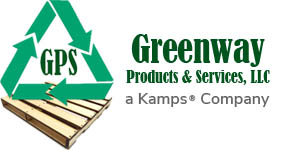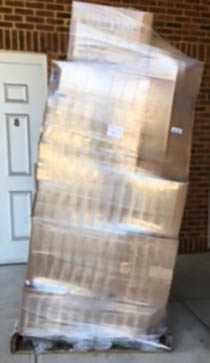
Some with what looks like minor imperfections. Others where the damage is more obvious.
The real cost of a damaged pallet far exceeds the pallet’s appearance.
Pallets are designed to carry load – much heavier loads than their low profile suggests. Moving product on a weak or compromised pallet has potential risk – to the valuable product it supports, and, even more costly, to the materials management personnel who work in warehouse and shipping jobs.
Understanding the true cost of damaged pallets – even those with what appears to be minor damage – is an important lesson for the packaging and fulfillment, and warehouse staff.
Damage to the pallet doesn’t have to be serious in order to create problems down the road. According to Laszlo Horvath, director of the Center for Packaging and Unit Load Design at Virginia Tech, even minor damage can compromise the integrity of the pallet, which can lead to product damage.
To truly reduce damage, start with the basics: choosing a better pallet and doing a better job of training employees. Staff need to:
- Recognize when a pallet is damaged
- Appreciate the risk and cost involved in using damaged pallets
- Know the procedures of separating damaged pallets and what they should do with them, and
- How to protect pallets from damage
1. Recognizing When a Pallet is Damaged
The best way to avoid damaged pallets is to invest in sturdy pallets at the beginning. A slightly higher initial cost is an investment that more than pays back over the life of its use. Inspect each pallet prior to stacking product on the pallet and avoid using pallets that:
- Have nails protruding or protruding slivers of wood
- Top or bottom boards are not in good condition, solid, and in place. Boards should not be cracked or have any missing pieces.
- Damaged or in poor condition stringers
2. Appreciating the Risk and Cost of Damaged Pallets
- Reduced costs. If you reduce pallet damage, you lengthen the life of your pallets and cut down on the number of units you have to buy or rent.
- Contamination Risks. Broken wooden chips, sawdust, and splinters can contaminate products they carry, as well as the workplace.
- Fire Risks. Wood chips and sawdust can easily catch fire, which can spread to products, and the warehouse.
- Avoid Injuries and Improve safety. Broken pallets and protruding nails can injure staff by tripping and puncture wounds.
- Reduce product damage. Pallets are designed to efficiently carry heavy loads of product. Fully packaged pallets are moved by forklifts over long distances, heights, on and off trucks and platforms. As the product moves from warehouse to warehouse to its final destination, over truck or ships, it encounters quick shifts in weight and sustained vibrations. A small weakness often will become stressed and grow to become a larger weakness, possibly collapsing completely. Collapsed pallets shift the load they carry and become much more dangerous to staff and the products they carry, as well as products stored on nearby pallets.
- Lower repair costs. United Pallet Services estimates that it costs $5 on average to fix a wooden pallet.
- Loss of Productivity
When a pallet fails, labor costs increase to cover the additional time it takes to cleanup, repack, and re-palletize. - Equipment Damage
As automation increases, the cost of damaged pallets on automated lines also increase. When a damaged pallet jams or damages automated equipment, the cost of the equipment service and repairs – not to mention line downtime – can be considerable.
3. How to Protect Pallets from Damage
93% of all pallets are made from wood, because they are reusable, repairable, and easily recyclable. Wood pallets are typically reused multiple times throughout their working lifespan, before they are shredded into Grade A landscaping mulch. The number of times a pallet can be reused largely depends on how well they are protected from damage. Reused pallets can significantly cut down on the number of pallets needed to be purchased.
The most successful distribution centers instruct their staff on a few, important pallet procedures.
Material Handling Procedures
- Do not push or drag pallets on floors with forklift trucks. That is, do not “bulldoze” pallets.
- Forklift and pallet jack operators are instructed to insert forks fully. When forks are not fully inserted, or “shortforked”, the operator is at risk of picking up the pallet at an angle, and the forklift ends could puncture the pallet underside.
- Pallets are not to be thrown or dropped.
- When loading a forklift, avoid hitting pallet corners or blocks
- Keep forklift forks or tines level when entering a pallet to avoid puncturing the pallet.
- Avoid using forklift forks, or tines, to push pallet load diagonally 90 degrees, sometimes referred to as pinwheeling.
- Slow down when entering a pallet to avoid slamming into the pallet. A 10,000 pound forklift and easily damage leader boards.
- Spread forklift forks or tines as wide as possible when entering a pallet.
- When carrying a pallet, tilt the forklift forks back slightly, resting the pallet on the forklift mast.
- Stack pallets in neat stacks to avoid toppling or being hit by moving forklifts. Stack pallets no more than 7 or 8 high, the maximum safe stack for people to reach. For higher stacks, use a forklift.
- Store pallets flat. Do not store pallets on their sides to avoid falling pallets and injuries.
- If forced to step on a pallet, step where there is a reinforcement board. Try to avoid stepping on pallets as much as possible.
- Use two people to lift large pallets. Do not pick up large pallets by yourself.
- For GMA standard sized 48”x40” 2-way pallets, both pallet jacks and forklifts can lift the pallet from the 40” side, but only forklifts can lift pallets from the 48” side.
- Separate reusable pallets from pallets that need repair.
Most pallet damage is caused by forklift trucks and pallet jacks. Take advantage of training materials provided by pallet vendors, whether they be posters, YouTube videos, or on-site training.
Consider special training for new hires and on-site poster reminders to reinforce the training on the warehouse floor.
Purchasing Department
In addition to training warehouse staff, purchasing needs to be provided with guidelines on your specific pallet requirements. Under constant pressure to reduce the initial purchase price, the purchasing staff may not recognize the true cost of pallets ill equipped to meet the load and strength requirements you require. Too often purchasing staff try to substitute cheaper pallets which often result in jumps in pallet damage, and unit load failures.
It may seem obvious, but if you want your pallets to last longer, you have to choose sturdier units in the first place. But how do you know if you’re buying a well-made pallet? You can start by making sure your pallets meet the standards laid out by MHI and the National Wooden Pallet and Container Association (NWPCA).
If you would like a consultation on how an optimally designed pallet can reduce your total costs, schedule a consult with Dominick Davi. You can reach him by email at dom@greenwaypsllc.com, or by phone at 516-437-6300.




Leave A Comment